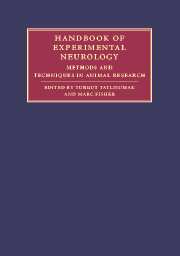Book contents
- Frontmatter
- Contents
- List of contributors
- Part I Principles and general methods
- Part II Experimental models of major neurological diseases
- 18 Focal brain ischemia models in rodents
- 19 Rodent models of global cerebral ischemia
- 20 Rodent models of hemorrhagic stroke
- 21 In vivo models of traumatic brain injury
- 22 Experimental models for the study of CNS tumors
- 23 Experimental models for demyelinating diseases
- 24 Animal models of Parkinson's disease
- 25 Animal models of epilepsy
- 26 Experimental models of hydrocephalus
- 27 Rodent models of experimental bacterial infections in the CNS
- 28 Experimental models of motor neuron disease/amyotrophic lateral sclerosis
- 29 Animal models for sleep disorders
- 30 Experimental models of muscle diseases
- Index
- References
29 - Animal models for sleep disorders
Published online by Cambridge University Press: 04 November 2009
- Frontmatter
- Contents
- List of contributors
- Part I Principles and general methods
- Part II Experimental models of major neurological diseases
- 18 Focal brain ischemia models in rodents
- 19 Rodent models of global cerebral ischemia
- 20 Rodent models of hemorrhagic stroke
- 21 In vivo models of traumatic brain injury
- 22 Experimental models for the study of CNS tumors
- 23 Experimental models for demyelinating diseases
- 24 Animal models of Parkinson's disease
- 25 Animal models of epilepsy
- 26 Experimental models of hydrocephalus
- 27 Rodent models of experimental bacterial infections in the CNS
- 28 Experimental models of motor neuron disease/amyotrophic lateral sclerosis
- 29 Animal models for sleep disorders
- 30 Experimental models of muscle diseases
- Index
- References
Summary
Introduction
We spend a significant part (about a third) of our lives sleeping, which is essential to our physical and psychological well-being. Sleep, however, is a fragile state that can easily be impaired by psychological stress or physical illness. For up to 10% of the general population, difficulty falling and/or maintaining sleep occurs several times a week (i.e., chronic insomnia). Some of these problems may be due to existences of obstructive sleep apnea syndrome, a condition that affects over 10% of the population, or due to restless leg syndrome (RLS)/periodic leg movement syndrome (PLMS), sleep-related involuntary leg movements often associated with an abnormal sensation in legs. Excessive daytime sleepiness (EDS), parasomnia, and sleep problems associated with medical/psychiatric conditions are also common. Narcolepsy is a primary EDS disorder affecting about 0.05% of the population. EDS is also often secondary to a severe insomnia associated with obstructive sleep apnea.
Many different pathophysiological/etiological mechanisms for these sleep disorders are considered, and the International Classification of Sleep Disorders (ICSD) lists over 84 different types of disorders (Table 29.1). These sleep-related problems are often chronic and negatively affect the subject's quality of life. In a 24-hr society that encourages sleep deprivation, daytime sleepiness is also an emerging issue even in healthy subjects. Accidents due to sleepiness are now well recognized as a major public hazard. The emergence of clinical sleep medicine has proceeded rapidly during the last 30 years with the awareness of these sleep problems.
- Type
- Chapter
- Information
- Handbook of Experimental NeurologyMethods and Techniques in Animal Research, pp. 504 - 543Publisher: Cambridge University PressPrint publication year: 2006



